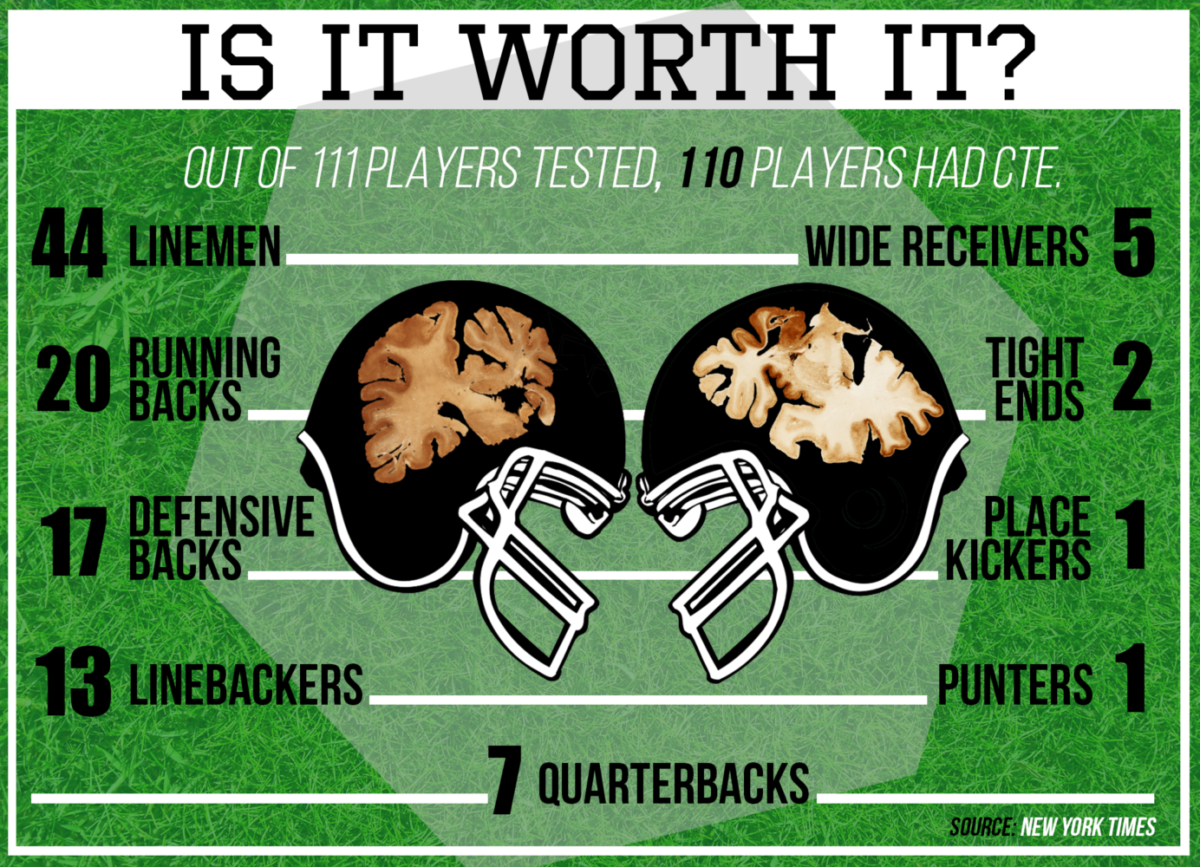Football’s head trauma problem: The reality of the sport
110 out of 111 former NFL players observed had chronic traumatic encephalopathy, commonly known as CTE according to the New York Times. CTE is the result of repeated head trauma over a long span of time.
September 28, 2017
Football is not safe. It has never been. It never will be. But what does this mean? What should we do with that information?
For a long time, the higher powers of football (the NFL and NCAA) have done nothing, that is until the public started making a fuss about it.
When I talk about football safety, I mean brain safety. Because in the end, a broken leg will not kill anyone 20 years down the line, yet something such as CTE (Chronic Traumatic Encephalopathy) has been silently killing and ruining the lives of football players since the first snap.
According to ConcussionFoundation.org, CTE is a product of repeated brain trauma such as concussions and those with it suffer symptoms including memory loss, constant headaches, depression, speech impediments, dementia and, in some cases, suicide. These symptoms have been found in people as young as 17, but often the effects are not seen until several years after the initial brain trauma.
CTE is real, although according to CBSsports.com Dallas Cowboys owner Jerry Jones seems to disagree, and it has been a problem from the very beginning of football; the tragedy is that until the mid-2000s CTE was considered to only occur in boxing, so for many football veterans it is too late.
New and improved helmets and small rule changes, such as targeting in the NCAA or head to head contact in the NFL, have been the institutional response to public backlash, but in reality, the game is only getting more violent and concussion filled.
CNN found an average of 243 concussions reported each year in the NFL from 2012-2016. The key word in the past sentence is “reported”, the majority of concussions are not reported and many players choose to stay on the field after obvious head trauma.
The sad part about this fact is that everyone knows it, coaches know when their players are concussed, teams’ medical staffs can tell, and fellow teammates without a doubt can recognize when something is wrong. It comes down to someone actually doing something.
In the past decade, progress has been made in leaps and bounds regarding concussions, there is no denying that. There is legitimate protocol for treating concussions other than parents, coaches and doctors alike chalking up a big hit to a player having his bell rung.
We have taken a step in the right direction, but the step taken is only in response. Concussions are near impossible to prevent with the way football is played now, and that is a problem.
Football will never change from the violent hits we see in every game today if rules were put in place to stop full speed contact the game would be unrecognizable.
Simply put, brain trauma in American football is unavoidable.
In 2017, we know that CTE is no longer some folktale told to scare people off from playing football, yet people still willingly sign up by the thousands to put pads on and play this dangerous game. Why? Because people love it. Because people do not seem to care.
Should they care? Yes. But does caring translate to not playing the game or altering it into something unrecognizable? That is something much more complex.
It has been common knowledge for years that foods like hamburgers and candy bars are a direct cause for diseases such as type II diabetes and obesity, yet these two items are readily accessible at any American corner store. The world has known smoking cigarettes is a direct cause of lung and throat cancer, yet every gas station and grocery store has cartons ready for purchasing.
There will never be a lack of kids wanting to play football, and there will never be a lack of fans ready to watch football. So is it ethical for parents to knowingly send their kids out onto the field or for fans to enjoy taking in a game while fully knowing that lives are at risk?
Like many Americans, football is my favorite sport to watch, I have been known to spend entire Saturdays watching all of the college games possible. Except for when a player gets carted off the field or is blatantly concussed, rarely does the long-term issue of CTE cross my mind.
Is this right? Should people who fully know the consequences of the game of football be able to enjoy it so much? That is up to the specific person.
Ultimately, from the NFL all the way down to eighth grade, the players themselves must be informed about the reality of football so that they can make their own personal decision to put their lives on the line.
Football never has and never will be safe, being a contact sport, the opportunity for head trauma will always be there. The future of the game will be dependant upon factual information about the dangers associated with playing.












Yvonne Harpole • Sep 29, 2017 at 12:17 pm
Great article, something parents & students should definitely think about when deciding whether to play or not. Thanks for the research.
Kim Valentine • Sep 28, 2017 at 10:00 pm
Great article Reid and very thought provoking. I guess I see life as a series of choices, and I will probably continue to watch those who choose to play the game and enjoy their choice to play, with all its risks, as long as they play.